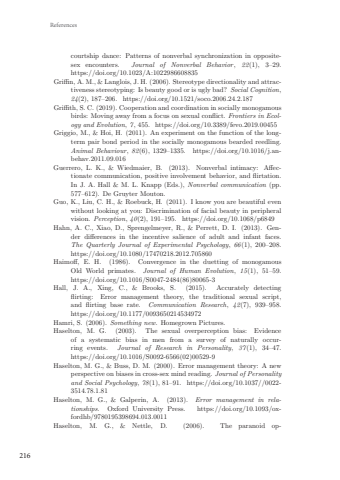Page 218 - Demo
P. 218
216Referencescourtship dance: Patterns of nonverbal synchronization in oppositesex encounters. Journal of Nonverbal Behavior, 22(1), 3–29.https://doi.org/10.1023/A:1022986608835Griffin, A. M., & Langlois, J. H. (2006). Stereotype directionality and attractiveness stereotyping: Is beauty good or is ugly bad? Social Cognition,24(2), 187–206. https://doi.org/10.1521/soco.2006.24.2.187Griffith, S. C. (2019). Cooperation and coordination in socially monogamousbirds: Moving away from a focus on sexual conflict. Frontiers in Ecology and Evolution, 7 , 455. https://doi.org/10.3389/fevo.2019.00455Griggio, M., & Hoi, H. (2011). An experiment on the function of the longterm pair bond period in the socially monogamous bearded reedling.Animal Behaviour, 82(6), 1329–1335. https://doi.org/10.1016/j.anbehav.2011.09.016Guerrero, L. K., & Wiedmaier, B. (2013). Nonverbal intimacy: Affectionate communication, positive involvement behavior, and flirtation.In J. A. Hall & M. L. Knapp (Eds.), Nonverbal communication (pp.577–612). De Gruyter Mouton.Guo, K., Liu, C. H., & Roebuck, H. (2011). I know you are beautiful evenwithout looking at you: Discrimination of facial beauty in peripheralvision. Perception, 40(2), 191–195. https://doi.org/10.1068/p6849Hahn, A. C., Xiao, D., Sprengelmeyer, R., & Perrett, D. I. (2013). Gender differences in the incentive salience of adult and infant faces.The Quarterly Journal of Experimental Psychology, 66(1), 200–208.https://doi.org/10.1080/17470218.2012.705860Haimoff, E. H. (1986). Convergence in the duetting of monogamousOld World primates. Journal of Human Evolution, 15(1), 51–59.https://doi.org/10.1016/S0047-2484(86)80065-3Hall, J. A., Xing, C., & Brooks, S. (2015). Accurately detectingflirting: Error management theory, the traditional sexual script,and flirting base rate. Communication Research, 42(7), 939–958.https://doi.org/10.1177/0093650214534972Hamri, S. (2006). Something new. Homegrown Pictures.Haselton, M. G. (2003). The sexual overperception bias: Evidenceof a systematic bias in men from a survey of naturally occurring events. Journal of Research in Personality, 37 (1), 34–47.https://doi.org/10.1016/S0092-6566(02)00529-9Haselton, M. G., & Buss, D. M. (2000). Error management theory: A newperspective on biases in cross-sex mind reading. Journal of Personalityand Social Psychology, 78(1), 81–91. https://doi.org/10.1037//0022-3514.78.1.81Haselton, M. G., & Galperin, A. (2013). Error management in relationships. Oxford University Press. https://doi.org/10.1093/oxfordhb/9780195398694.013.0011Haselton, M. G., & Nettle, D. (2006). The paranoid opIliana Samara 17x24.indd 216 08-04-2024 16:37


